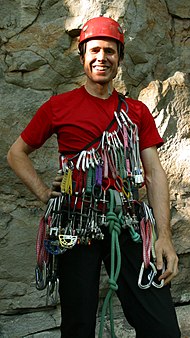
Back Equip d'escalada Catalan Equipo para escalada Spanish رده:مقالههای ویکیپروژه نسخه آفلاین درباره climbing equipment Persian Matériel d'escalade French Tırmanma malzemeleri Turkish
| Part of a series on |
| Climbing |
|---|
 |
| Lists |
| Types of rock climbing |
| Types of mountaineering |
| Other types |
| Key actions |
| Key terms |
Rock-climbing equipment varies with the type of climbing undertaken. Bouldering needs the least equipment outside of shoes and chalk and optional crash pads. Sport climbing adds ropes, harnesses, belay devices, and quickdraws to clip into pre-drilled bolts. Traditional climbing adds the need for carrying a "rack" of temporary passive and active protection devices. Multi-pitch climbing (and big wall climbing) adds devices to assist in ascending and descending fixed ropes. Finally, aid climbing uses unique equipment (e.g. aiders).
Advances in equipment are a key part of the rock climbing history, starting with the climbing rope. Modern devices enable climbers to perform tasks that were previously done manually, and with greater control (in all conditions) and less effort. Examples of replacements include the harness (replaced tieing the rope around the waist), the carabiner (replaced many knots), the descender/abseil device (replaced the dülfersitz), the ascender (replaced the prusik knot), the belay device (replaced the body belay), and nuts/hexes (replaced chockstones).
Modern equipment includes dynamic ropes, plyometric training tools, advanced spring-loaded camming devices (SLCDs) for protection, and advanced rope control devices such as self-locking devices (SLDs), progress capture devices (PCDs), and assisted braking devices (ABDs). Modern equipment uses advanced materials that are increasingly more durable, stronger, and lighter (e.g. spectra/dyneema and aluminum alloys). The equipment must meet specific standards (e.g. the UIAA standards) for strength, durability, and reliability, and must be certified and tested against such standards (with individual pieces carrying such certification marks).